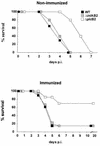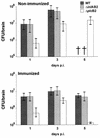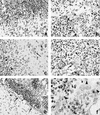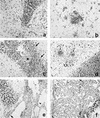Phosphatidylcholine-specific phospholipase C from Listeria monocytogenes is an important virulence factor in murine cerebral listeriosis
- PMID: 9826375
- PMCID: PMC108751
- DOI: 10.1128/IAI.66.12.5930-5938.1998
Phosphatidylcholine-specific phospholipase C from Listeria monocytogenes is an important virulence factor in murine cerebral listeriosis
Abstract
Meningoencephalitis is a serious and often fatal complication of Listeria monocytogenes infection. The aim of the present study was to analyze the role of internalin A (InlA) and B, which are involved in the invasion of L. monocytogenes into cultivated host tissue cells, and that of phosphatidylcholine-specific phospholipase C (PlcB), which mainly promotes the direct cell-to-cell spread of L. monocytogenes, in murine cerebral listeriosis by use of an InlA/B (DeltainlAB2)- and a PlcB (DeltaplcB2)-deficient isogenic deletion mutant strain and the wild-type (WT) L. monocytogenes EGD. Listeria strains were directly applied to the brain, a technique which has been employed previously to study the pathogenesis of cerebral listeriosis (D. Schlüter, S. B. Oprisiu, S. Chahoud, D. Weiner, O. D. Wiestler, H. Hof, and M. Deckert-Schlüter, Eur. J. Immunol. 25:2384-2391, 1995). We demonstrated that PlcB, but not InlA or InlB, is an important virulence factor in cerebral listeriosis. Nonimmunized mice infected intracerebrally with the DeltaplcB2 strain survived significantly longer and had a reduced intracerebral bacterial load compared to mice infected with the DeltainlAB2 strain or WT bacteria. In addition, immunization with the WT prior to intracerebral infection significantly increased the survival rate of mice challenged intracerebrally with the DeltaplcB2 strain compared to that of mice infected with the WT or DeltainlAB2 strain. Histopathology revealed that the major difference between the various experimental groups was a significantly delayed intracerebral spread of the DeltaplcB2 mutant strain, indicating that cell-to-cell spread is an important pathogenic feature of cerebral listeriosis. Interestingly, irrespective of the Listeria mutant used, the apoptosis of hippocampal and cerebellar neurons and an internal hydrocephalus developed in surviving mice, indicating that these complications are not dependent on the virulence factors InlA/B and PlcB. In conclusion, this study points to PlcB as a virulence factor important for the intracerebral pathogenesis of murine L. monocytogenes meningoencephalitis.
Figures





Similar articles
-
Directed evolution and targeted mutagenesis to murinize Listeria monocytogenes internalin A for enhanced infectivity in the murine oral infection model.BMC Microbiol. 2010 Dec 13;10:318. doi: 10.1186/1471-2180-10-318. BMC Microbiol. 2010. PMID: 21144051 Free PMC article.
-
Relative Roles of Listeriolysin O, InlA, and InlB in Listeria monocytogenes Uptake by Host Cells.Infect Immun. 2018 Sep 21;86(10):e00555-18. doi: 10.1128/IAI.00555-18. Print 2018 Oct. Infect Immun. 2018. PMID: 30061379 Free PMC article.
-
Influence of internalin A murinisation on host resistance to orally acquired listeriosis in mice.BMC Microbiol. 2013 Apr 23;13:90. doi: 10.1186/1471-2180-13-90. BMC Microbiol. 2013. PMID: 23617550 Free PMC article.
-
Role of internalin proteins in the pathogenesis of Listeria monocytogenes.Mol Microbiol. 2021 Dec;116(6):1407-1419. doi: 10.1111/mmi.14836. Epub 2021 Nov 7. Mol Microbiol. 2021. PMID: 34704304 Review.
-
Listeria pathogenesis and molecular virulence determinants.Clin Microbiol Rev. 2001 Jul;14(3):584-640. doi: 10.1128/CMR.14.3.584-640.2001. Clin Microbiol Rev. 2001. PMID: 11432815 Free PMC article. Review.
Cited by
-
Beta-casein-derived peptides, produced by bacteria, stimulate cancer cell invasion and motility.EMBO J. 2003 Nov 17;22(22):6161-73. doi: 10.1093/emboj/cdg586. EMBO J. 2003. PMID: 14609961 Free PMC article.
-
CD44-regulated intracellular proliferation of Listeria monocytogenes.Infect Immun. 2003 Jul;71(7):4102-11. doi: 10.1128/IAI.71.7.4102-4111.2003. Infect Immun. 2003. PMID: 12819101 Free PMC article.
-
Rhombencephalitis Caused by Listeria monocytogenes in Humans and Ruminants: A Zoonosis on the Rise?Interdiscip Perspect Infect Dis. 2010;2010:632513. doi: 10.1155/2010/632513. Epub 2010 Feb 28. Interdiscip Perspect Infect Dis. 2010. PMID: 20204066 Free PMC article.
-
Interaction of Macrophages and Cholesterol-Dependent Cytolysins: The Impact on Immune Response and Cellular Survival.Toxins (Basel). 2020 Aug 19;12(9):531. doi: 10.3390/toxins12090531. Toxins (Basel). 2020. PMID: 32825096 Free PMC article. Review.
-
Colony-stimulating factor 1-dependent cells protect against systemic infection with Listeria monocytogenes but facilitate neuroinvasion.Infect Immun. 2002 Aug;70(8):4682-6. doi: 10.1128/IAI.70.8.4682-4686.2002. Infect Immun. 2002. PMID: 12117983 Free PMC article.
References
-
- Berche P. Bacteremia is required for invasion of the murine central nervous system by Listeria monocytogenes. Microb Pathog. 1995;18:323–336. - PubMed
-
- Bogdan I, Leib S L, Bergeron M, Chow L, Täubner M G. Tumor necrosis factor-alpha contributes to apoptosis in hippocampal neurons during experimental group B streptococcal meningitis. J Infect Dis. 1997;176:693–697. - PubMed
-
- Braun L, Dramsi S, Dehoux P, Bierne H, Lindahl G, Cossart P. InlB: an invasion protein of Listeria monocytogenes with a novel type of surface association. Mol Microbiol. 1997;25:285–294. - PubMed
-
- Chakraborty T, Wehland J. The host cell infected with Listeria monocytogenes. In: Kaufmann S H E, editor. Host response to intracellular pathogens. R. G. Austin, Tex: Landes Company; 1997. pp. 271–290.
-
- Domann E, Zechel S, Lingnau A, Hain T, Darji A, Nichterlein T, Wehland J, Chakraborty T. Identification and characterization of a novel PrfA-regulated gene in Listeria monocytogenes whose product, IrpA, is highly homologous to internalin proteins, which contain leucine-rich repeats. Infect Immun. 1997;65:101–109. - PMC - PubMed
Publication types
MeSH terms
Substances
LinkOut - more resources
Full Text Sources
Other Literature Sources

